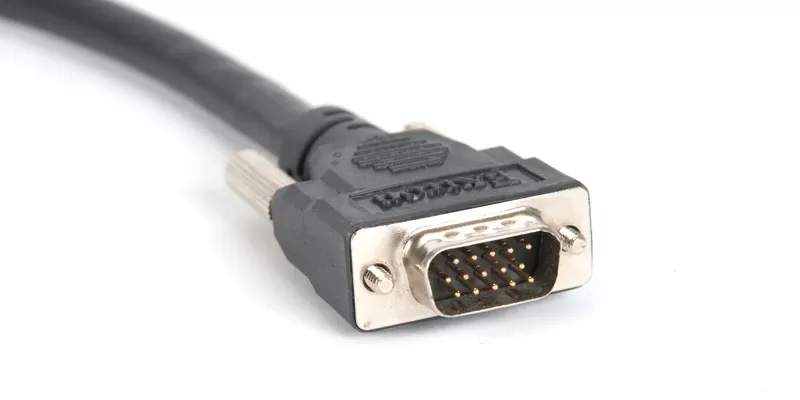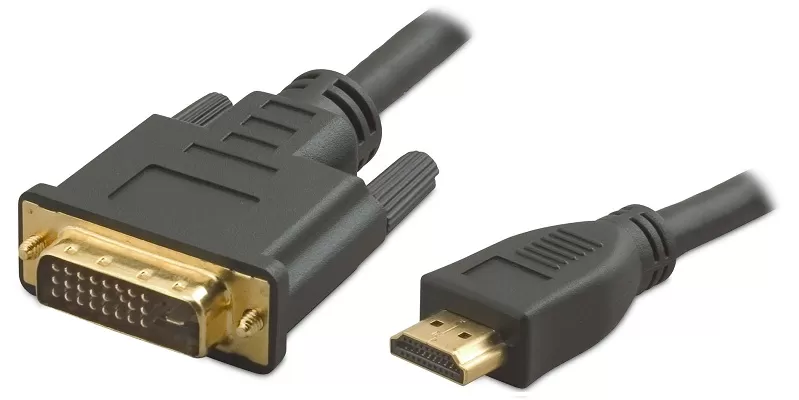
Compare DVI and HDMI | What is the difference
DVI and HDMI are digital video signal transmission interfaces. They are designed to connect external displays — to a computer, tablet, game console, or generally any device capable of playing video. However, there is a fundamental difference between these two standards.
In this article, we will describe in detail the difference between these two protocols and tell you which monitors and video cards to choose in 2019.
The main difference between DVI and HDMI
The main difference between DVI and HDMI is that the latter is capable of transmitting not only video, but also sound. The first one transmits only the video stream, for audio playback it is proposed to connect external speakers to the appropriate expansion card (sound card or similar device).
In addition, the maximum video stream resolution in the HDMI 2.0 protocol is 4K (3840 × 2160 pixels) at a refresh rate of 50/60 Hz. For the “competitor”, this parameter is 1920 × 1200 pixels at a scanning frequency of 60 Hz (and 1920 × 1080 pixels at 75 Hz). But it can be doubled when using Dual Link technology.
However, when comparing these parameters, it is worth considering the generation of the protocol. The difference between DVI and HDMI of different families can be significant.
Specifications and History of DVI

DVI was originally developed as an interface for connecting a display to a computer. Due to the rather large size of the connector itself, it is rarely used in mobile devices and laptops. In addition, this standard is actually outdated at the moment (2019).
This name refers to a whole group of protocols that have different technical characteristics:
-
DVI-A – completely analog data transmission standard. In this it is similar to VGA, has the same technical characteristics. Hopelessly outdated and in 2019 found only in the oldest computers; -
DVI-I Single Link – Supports both analog and digital transmission. Compatible with almost all displays, both old and new. The video card itself determines which type of sent data to activate and provides the best display; -
DVI-I Dual Link – Supports both analog and digital transmission. In addition, he has a second set of contacts for «numbers». This increases the maximum resolution of connected screens — up to 2560 × 1600 pixels; -
DVI-D Single Link – a standard that supports only digital data transmission. The maximum resolution on it is 1920 × 1200 pixels, and the refresh rate is 60 Hz; -
DVI-D Dual Link – digital data transmission protocol with two channels. This provides a maximum resolution of 2560 × 1600 pixels, a refresh rate of 120 Hz, and support for NVIDIA 3D Vision technology.
Versions differ not only in technical characteristics, but also in connectors.
DVI iteration comparison table
|
Characteristic
|
DVI-A
|
DVI-DSL
|
DVI-D DL
|
DVI-I SL
|
DVI-I DL
|
|
Max. resolution, dots
|
1920×1080
|
1920×1200
|
2560×1600
|
1920×1200
|
2560×1600
|
|
Max. sweep frequency at max. resolution, Hz
|
60
|
60
|
120
|
60
|
120
|
|
Number of analog channels
|
one
|
0
|
0
|
one
|
one
|
|
Number of digital channels
|
0
|
one
|
2
|
one
|
2
|
|
Max. cable length while maintaining max. lossless resolution, m (indicated without amplification)
|
fifteen
|
10.5
|
10.5
|
10.5
|
10.5
|
|
Application
|
Old monitors that only support analog data
|
Screens with a matrix up to Full HD
|
Screens with a matrix higher than Full HD
|
Screens with a matrix up to Full HD, old devices with exclusively «analogue»
|
Screens with a matrix higher than Full HD, old devices with exclusively «analogue»
|
In 2019, the use of this standard is only advisable if you want to connect a projector to your computer. But it has a high maximum cable length for lossless transmission.
Connectors of various iterations are backward compatible at the hardware level. This means that DVI-A, DVI-D and DVI-I plugs can be plugged into the DVI-I DL connector, but only DVI-A can be plugged into the DVI-A connector. Connectors differ in the number of pins.
HDMI specifications and history

This interface was originally developed as a universal standard for transmitting a multimedia signal that includes both a video stream and an audio stream. It is suitable for connecting monitors with built-in speakers, TVs, projectors, and similar devices to your computer.
There are several generations of this protocol. They differ primarily in bandwidth — that is, the amount of content that can be transmitted.
Difference between iterations (only the most common generations are included in the table):
|
|
|
|
|
|
|
Max. resolution of the transmitted video signal, dots
|
1920×1080
|
2560×1440
|
3840×2160
|
10240×4320
|
|
Maximum sweep frequency at full resolution, Hz
|
60
|
60
|
60
|
120
|
|
Max. number of audio channels
|
eight
|
eight
|
32
|
32
|
|
Max. transmitted sound frequency, kHz
|
192
|
768
|
1536
|
1536
|
|
Maximum color depth, bit
|
24
|
48
|
48
|
48
|
|
Support for DTS, Dolby Digital 5.1 audio technologies
|
Yes
|
Yes
|
Yes
|
Yes
|
|
Support for Dolby TrueHD and DTS-HD audio technologies
|
Not
|
Yes
|
Yes
|
Yes
|
|
3D Format Enhancement Technologies
|
Not
|
Not
|
Yes
|
Yes
|
|
Aspect Ratio 16:9
|
Yes
|
Yes
|
Yes
|
Yes
|
|
Aspect Ratio 21:9
|
Not
|
Not
|
Yes
|
Yes
|
|
Video stream with HDR
|
Not
|
Not
|
Yes
|
Yes
|
|
Maximum cable length without amplification, m
|
5
|
5
|
5
|
5
|
|
Maximum length of active cable without amplification, m
|
fifteen
|
fifteen
|
fifteen
|
fifteen
|
|
Release of the first devices supporting this generation, year
|
2002
|
2006
|
2015
|
2017
|
Versions are backwards compatible at the software level. This means that if, for example, the video card supports version 2.1, but the monitor supports only 1.0, then the characteristics of the transmitted data will correspond to generation 1.0. Similarly, if the video card has 1.0 and the screen has 2.1, then the characteristics will correspond to 1.0. The data transfer rate and their number are always «cut off» by the older generation in the bundle.
It is also worth noting the existence of two types of cables — regular and «active». The active cable is made of optical fiber and is equipped with converters that turn electricity into a light signal (and vice versa). And a regular wire is just a set of copper conductors. This explains the difference in the maximum cable length.
Difference between HDMI and DVI in table form
Let’s compare the technical characteristics of the three standards — DVI-I DL as the most modern in its family, HDMI 1.3 as the most common in the previous generation of video equipment and its more recent iteration 2.0b as the most common in the current generation of video equipment.
For a clearer understanding of the difference between generations of technology, it is worth giving an example:
-
The Sony PlayStation 4 game console was released in 2013 and is equipped with an interface version 1.4;
-
The Sony PlayStation 4 Pro game console was released in 2016 and is equipped with an interface version 2.0b — and therefore supports 4K TVs and high dynamic range HDR.
Now you can go to the table illustrating the difference between these standards:
|
|
|
|
|
|
Maximum resolution of the connected screen, dots
|
2560×1600
|
2560×1440
|
3840×2160
|
|
Maximum refresh rate at this resolution, Hz
|
120
|
60
|
60
|
|
3D support
|
Limited (using NVIDIA 3D Vision technology)
|
Limited
|
Complete
|
|
HDR support
|
Not
|
Not
|
Yes
|
|
Sound support
|
Not
|
Yes
|
Yes
|
|
Support high quality audio with high bitrate
|
Not
|
Not
|
Yes
|
|
Support for «long» screens
|
With VGA-like vertical dot count
|
With FHD-like vertical dot count
|
Yes
|
|
Maximum length of the «ordinary» cable, m
|
10.5
|
5
|
5
|
|
Maximum length of the active cable, m
|
—
|
fifteen
|
fifteen
|
|
Maximum cable length with amplification, m
|
61
|
Not limited
|
Not limited
|
Thus, this table illustrates the most important difference between the two standards. This is already enough to select the appropriate connection interface.
Which connector to choose — HDMI or DVI — depending on situations

If there is a choice of protocol for connecting a particular device, then you can not “dig into” the characteristics of the interfaces. We have compiled a table that will help you determine which connector is best to use, and why.
It is worth mentioning right away that we are talking about a DVI-I DL connector. Otherwise, the interface version is specified.
-
DVI is best used when you need to connect:
-
An old monitor with an aspect ratio of 4:3. It most likely uses an analog interface;
-
Office «display» with a matrix of about Full HD. This standard has sufficient characteristics to be displayed on such a screen, and the wire is corny cheaper;
-
Full HD gaming monitor. DVI-I DL provides a refresh rate of up to 120 Hz and thus increases the frame rate;
-
Projector. This is due to the fact that the maximum length of the wire without amplification is 10-15 meters, depending on the number of points displayed on the screen.
-
HDMI is best used if you need to connect:
-
Monitor with built-in speakers, as the interface transmits sound;
-
TV to computer. And not only because of the ability to transmit sound, but also because this protocol is standard for multimedia in general, so the TV most likely has a corresponding connector;
-
Monitor or TV that supports HDR. An extended dynamic range of shades can only be transmitted using this protocol, and only versions 2.0a and 2.0b;
-
Console for TV. Again, this protocol provides sound transmission;
A gaming monitor that has a Full HD resolution and a matrix response speed of up to 3 ms. Only this standard provides sufficient bandwidth for very high frame rates.
It is worth considering that these life hacks do not take into account the most modern video signal transmission interface — DisplayPort.
Conclusion
Despite all its advantages, DVI is gradually being phased out. Modern video cards and monitors are often simply not equipped with the appropriate connector. It is gradually being replaced by HDMI, which will be replaced by DisplayPort.
And when buying a modern computer, laptop, video card or game console, the whole difference between DVI and HDMI is that the device has the first connector, but not the second.
Добавить комментарий
Для отправки комментария вам необходимо авторизоваться.